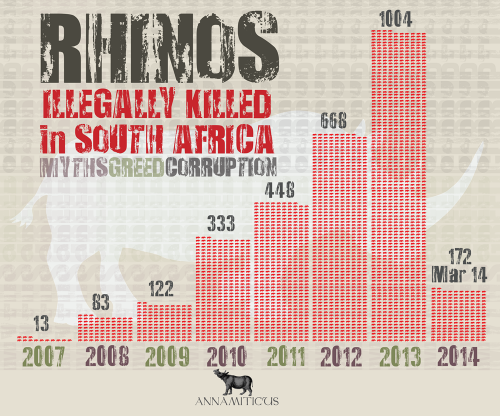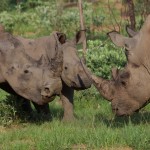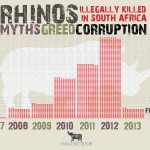
The first quarter of 2014 is shaping up to be a deadly one for South Africa’s rhinos, with at least 172 killed as of March 14.
Of the total, 113 rhinos were killed in Kruger National Park, according to the country’s Department of Environmental Affairs. Although 54 people have reportedly been arrested for rhino crimes, this number accounts mainly for “poachers” and couriers, not kingpins or even mid-level operators.
Unfortunately, there have been very few significant arrests of rhino horn traffickers in South Africa since 2011, when safari outfitter Marnus Steyl and Thai national Chumlong Lemtongthai were found to be working together, using trophy hunt loopholes to launder rhino horns for the illegal market. Lemtongthai is currently serving a 30-year prison sentence (reduced from 40 years) for his involvement, and an INTERPOL Red Notice was issued at the request of South Africa for another Thai national linked to the trophy hunt scam, Punpitak Peter Chunchom.
It is indeed troubling to note — particularly when compared to Lemtongthai — that the South African, Marnus Steyl, has remained relatively unscathed for hosting the bogus rhino hunts on his property. Steyl’s next scheduled court appearance is March 31, 2014.
The rate of rhinos being killed in South Africa since the beginning of this year appears similar to 2013. As of February 28, 2013, 128 rhinos had been killed; by March 27, the death toll had reached 188.
One of South Africa’s responses to the rhino crisis has been to push for a legalized trade in rhino horn, claiming that the carnage is simply a “matter of supply and demand” — even dubbing the topic “rhino-nomics” at an elaborate CITES CoP16 side event. However, South Africa’s “rhino horn economics” argument fared poorly when subjected to expert scrutiny at the International Wildlife Trafficking Symposium in London in February. (See South Africa’s Rhino Horn Trade Scheme Trounced by Economics.)
The current crisis in South Africa became apparent in 2008 when 83 rhinos were illegally killed, compared to 13 in 2007. Then the South African government issued a moratorium on domestic rhino horn trade. Following that, the rhino death toll shot up to 122 in 2009 and 333 in 2010. Meanwhile, the proliferation of “pseudo-hunts” (using South African trophy hunts as a front for illegal sourcing of horns) attracted unwanted international attention. The timeline of loophole closure vs. illegal killings suggests that some of South Africa’s private rhino owners had been participating in the illegal market prior to the moratorium by using the domestic trade loophole.
In an attempt to close the second loophole which allowed pseudo-hunts, restrictions were later tightened on foreign hunters, with mixed results. When Vietnamese and other Asian “hunters” came under scrutiny, paper hunters were next recruited from the Czech Republic. (See South Africa’s Trophy Hunt Industry Linked to Rhino Horn Trafficking … Again.)
South Africa has yet to join the international community in demand reduction efforts — indeed, it could be argued that the pro-trade lobby is doing whatever it can to ensure demand for rhino horn remains strong. The next trade loophole we can anticipate South Africa to exploit is the “captive breeding operation”, by which the CITES Convention allows commercial trade of Appendix I specimens bred in a registered captive breeding operation. (See Rhino Horn: Debunking the Pro-Trade Propaganda.)
And this deadly scourge is affecting other rhino range states. This year, Kenya has lost 13 rhinos to the illegal trade, while in India, nine rhinos have been gunned down in Kaziranga National Park.




